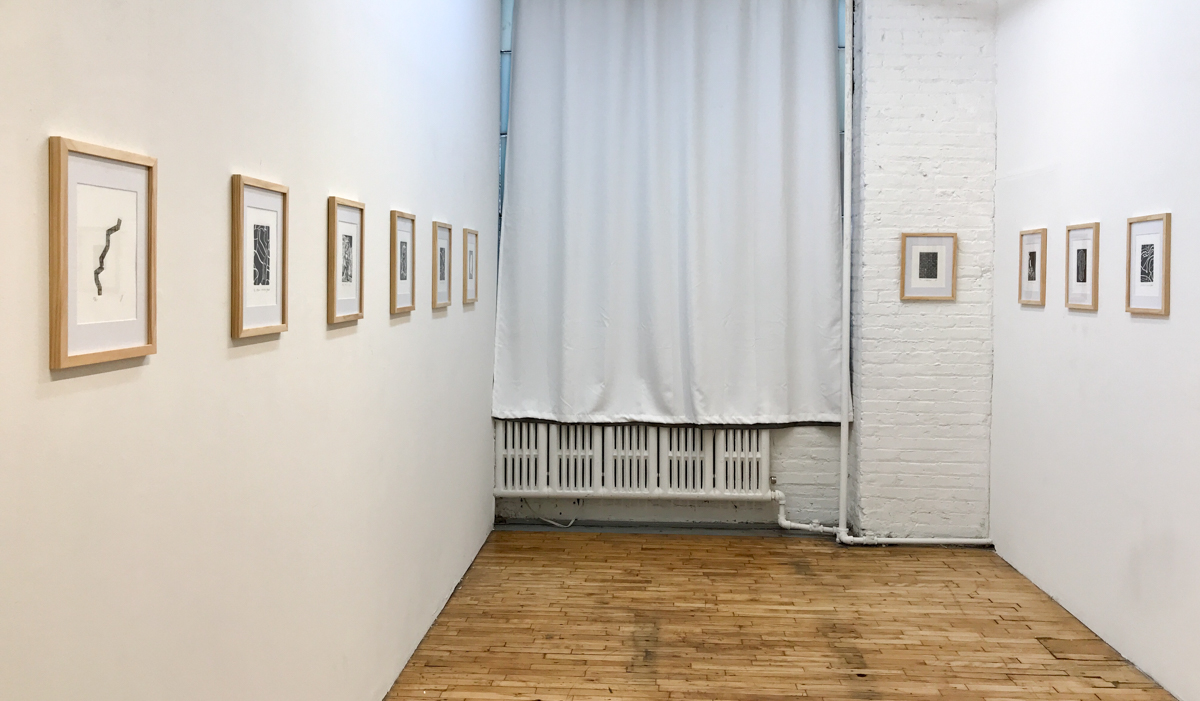
“Deriva” at The Border Gallery
Participating artists: Diego Anaya, Pablo Caviedes, Hermann Mejía, Moses Ros, and Carlos Torres
Curated by Graciela Kartofel
Nov 8 – Dec 1, 2019
Diego Anaya, Pablo Caviedes, Hermann Mejía, Moses Ros, and Carlos Torres Machado are the five artists who are part of the ArteLatAm collective, producing artwork in various disciplines. They are now presenting their first portfolio of prints, entitled Deriva / Adrift: The Migrant Experience. This linoleography edition of twenty-five prints and three artist’s proofs, in 11’ x 8.5”, deals with a very significant topic all over the world.
The Migrant Experience is rooted in the history of the world. One can even say that it is rooted in humanity itself. Migration is not a one-way action, nor does it have only one reason for being or a specific beginning and end. The art experience is equally rooted in the world’s history. In the sentence above, the word ‘art’ can easily replace the word ‘migration’ and it would all still make perfect sense. Both terms are intertwined, and both have to do with origin and survival. Humanity has survived many natural disasters and wars. The suffering of people adrift, trying to escape violence, torture, famine, flooding, and more, frames situations like family separation and lives lost in the process of fleeing.
Each artist created a tryptic with titles and images that reveal the five different aesthetic approaches.
Diego Anaya, a Mexican-American artist, presents Thread #1, #2, and #3, a trio of black-and-white prints that relate to sown fields, a road, and a path-through. These prints are abstract geometric drawings which the artist created using the linoleum graphic process. Linear, squared, and diamond-like patterns appear throughout the prints. It could very well be understood as a reference to the people who live in the country, those who must flee through a path, the road itself, solitary, isolated, and with unexpected risks. If one would not try to interpret the images through the lens of reality, one could understand that this artist created an aesthetic geometric triad.
Pablo Caviedes, an Ecuadorean-American artist who has a professional relationship to France, created three prints that can be understood as going from figurative to abstract or vice versa, depending on whether one begins looking at them from the right or from the left. Their titles are On the map #1, #2, and #3. A squared black rim with rounded angles frames each print, giving depth to the imagery, and a variety of graphic doodle signs saturate the surface of the prints except in the central part, where a form—an island-head shape—emerges. Coincidentally, one could understand the empty central form as that, an empty form. The other print has an inventive articulation of a pirate or an Afro figure migrating into the form, and the third central presence is Pablo’s self-portrait, evocative of Picasso’s self-portrait.
Hermann Mejia, a Venezuelan-American artist, calls his prints Yendo #1, #2, and #3. This Spanish word means ‘going’; the verb is active and refers to an action with no relation to when or where the person will stop or arrive. It is an open expression that does not include a time frame; it is related to movement, departure, moving away. Hermann Mejía’s figurative expressionist, narrative drawings have textural gestures placing and defining each of the three figures, one in each print. A tragic expression of sadness, solitude, fear, and anguish prevails. It is a reflection of people in motion, a destiny of not being settled.
Moses Ros is a Dominican-American artist and, as an established printmaker, is the leader of this project. Moses Ros creates mobiles based on prints. He is also the creator of numerous public art sculptures and incorporates public interaction in many of his artworks. His semi-figurative prints use a few synthetic lines to communicate his ideas. In Avioneta / Airplane, a woman, representing an airplane, longs to take flight from her situation. In Enraizamiento / Taking Root, a man’s body absorbs the gestural surroundings as he puts down his roots in a new environment. Mentalmente / Mentally shows a head, a plaster sculpture drawn in white against the black-inked surface of the print, representing how one sees oneself. In all three prints, black is used as a way of intensifying the drama.
Carlos Torres Machado, an Ecuadorean-American artist, refers to something universal like neighborhood in the titles: Mi Barrio, Tu Barrio, El Barrio, meaning My Neighborhood, Your Neighborhood, The Neighborhood. The lines of varied thickness draw invented maps that feature open-ended roads. One could understand this as a positive expression for the people who emigrate. The Migrant Experience can be more difficult when it is enclosed, and limited. Although choosing among many open roads can create anxiety, at least they are open opportunities. These artworks have a predominance of organic forms and curves that orient the prints in the human realm, and one can discover a couple of figures as well.
In the digital era, communicating
via a print portfolio is an interesting approach,
as it maintains the manual aesthetic experience
as well as offering a technical challenge.
This dynamic encourages us
to believe that the world is looking for solutions,
and that challenges can be transformed into opportunity.
Graciela Kartofel
CRSA, AICA-NY, CAA, PEN
The Border Gallery | thebordergallery@gmail.com | Instagram: @the_border_gallery